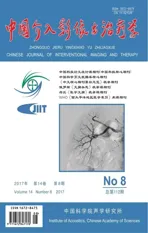Progresses of interventional treatment in biliary stenosis
2017-01-14,,,
, , ,
(Department of Radiology, Chinese Academy of Medical Sciences, Peking UnionMedical College Hospital, Beijing 100730, China)
·综述·
Progresses of interventional treatment in biliary stenosis
ZHOUKang,SHIHaifeng,JINZhengyu,PANJie*
(DepartmentofRadiology,ChineseAcademyofMedicalSciences,PekingUnionMedicalCollegeHospital,Beijing100730,China)
Interventional therapy is an important treatment for biliary stenosis. The treatment methods are different according to the different causes. Conventional interventional therapy include biliary drainage, balloon dilatation and stent implantation. There are some new treatment methods such as radiofrequency catheter ablation and biliary stent loaded with125I seeds. The applications of interventional therapy in biliary stenosis were reviewed in this article.
Interventional therapy; Biliary stenosis; Percutaneous transhepatic cholangiography; Stents
胆道狭窄可由胰腺癌、胆管癌、转移癌、慢性胰腺炎及术后损伤等疾病引起,主要病症为黄疸,其次为肝功能失代偿、胆管硬化、疼痛、皮肤瘙痒及化脓性胆管炎等。传统介入治疗方法为导管引流、球囊扩张、支架植入等,近年来新出现的胆道内射频消融、支架联合放射性125I粒子植入等方法,现已逐渐在临床应用。本文就介入治疗在不同病因引起的胆道狭窄性疾病中的应用进行综述。
1 恶性胆道狭窄
恶性疾病导致的胆道狭窄占70%~90%[1-2],常见恶性病变为胆管癌和胰头癌[3-4],其次为胆囊癌、胃癌、肝转移癌和肝门部淋巴结转移。根据恶性胆道狭窄能否手术,其介入治疗方法不同。
1.1可手术的恶性胆道狭窄 介入治疗的目的在于术前减小胆道系统压力,降低血清胆红素水平,恢复正常肝功能。经皮经肝胆道造影术(percutaneous transhepatic cholangiography, PTC)和引流为最佳选择。PTC采用21G细针穿刺系统于超声或X线透视引导下实施,肝右叶胆管穿刺由右侧腋中线入路,肝左叶胆管穿刺由剑突下入路;只需置入外引流,内引流有逆流感染引发胆管炎的风险[5]。对于胆道感染患者,对比剂的注入压力不能过高,以防发生菌血症;可于胆道主干内置入多边孔猪尾引流管,并固定于患者皮肤上。如无法行超声内镜,可通过PTC路径行病灶组织学活检。
PTC并发症包括出血、化脓性胆管炎、菌血症、腹膜炎、胆瘘及气胸等。有研究[6]报道,根据2012年介入放射学会指南,不需进一步治疗或仅需对症支持治疗的PTC轻微并发症发生率为2%;需采取进一步治疗措施,或致患者住院时间48 h以上的严重并发症,如菌血症发生率为2.5%,出血为2.5%,严重炎症(脓肿、腹膜炎、胆管炎和胰腺炎的总发生率)为1.2%;死亡率为1.7%。PTC操作相关死亡率为0.6%~5.6%[7-8]。Uberoi等[9]研究发现,接受PTC治疗的患者于住院期间的死亡率为19.8%(121/610)。Tapping等[10]研究发现PTC操作相关的死亡率为2%。
1.2无法手术的恶性胆道狭窄
1.2.1 胆道支架植入 对于无法手术的恶性胆道狭窄,以姑息治疗胆道支架植入术为主,胆道引流保留了患者的正常肝功能使其能接受放化疗,胆道支架可让胆汁通过正常生理通道进入肠道,从而保证了患者的生存质量。研究[11]表明,恶性胆道狭窄患者行胆道支架的死亡率和并发症发生率较手术更低。肝门部肿瘤引起的恶性胆道狭窄,可采取PTC同时穿刺左右两侧肝内胆道,置入2个支架呈“Y”型;如双侧路径不成功,也可从一侧入路,置入2个支架呈“7”型。Vienne等[12]认为姑息治疗肝门区域恶性胆道狭窄的有效标准为引流体积超过肝体积的50%,30天内血清胆红素下降超过50%。首先应用于临床的胆道支架是塑料支架[13],随后为自膨式金属支架(self-expandable metal stents, SEMS)[14]。
塑料支架材质分为聚乙烯(polyethylene, PE)、聚氨酯(polyurethane, PU)和聚四氟乙烯,不同材质患者的死亡率和发病率相似[15]。Cheon等[16]采用PU与PE支架治疗肝门部胆道梗阻的随机对照研究表明,PU支架的移位发生率低于PE支架(5% vs 29%),两者通畅时间比较,差异无统计学意义(P=0.032)。Kadakia等[13,16]研究发现10F的塑料支架比8F通畅时间更长,但11.5F和12F与10F相比无统计学意义(P均<0.05)。
SEMS是由不同的金属如不锈钢、铂、镍、钛或合金制成的金属网状圆柱体,具有一定的支撑力以保持形状并可撑开狭窄段。塑料支架的不足为其孔径的限制导致通畅时间有限,而SEMS的输送器直径为6F~7F,支架展开后的孔径可达30F,可显著增加通畅时间。研究[17-19]表明与塑料支架相比,SEMS不易堵塞,且在技术成功率、并发症发生率和死亡率比较差异无统计学意义(P均<0.05)。
不覆膜SEMS可附着于胆道壁,减少胆道移位的发生,但肿瘤组织可沿金属网格空隙向腔内生长,导致再狭窄,需再置入支架。其6个月再狭窄率为20%~50%[20]。覆膜SEMS是于SEMS表面覆盖一层薄膜,成分为聚四氟乙烯、含氟乙烯—丙烯或硅膜。其优势为肿瘤组织无法沿金属网格向内生长,再狭窄的发生率减少,且支架可再回收利用;不足为支架移位的风险增加。Kahaleh等[21]对101例胆道肿瘤患者植入半覆膜SEMS Wallstents支架,仅3例于术后12个月出现支架堵塞,且原因并非肿瘤向内生长。Zhu等[22]研究发现,125I粒子置入联合胆道支架组患者生存时间长于普通SEMS组(7.4个月vs 2.5个月)。
1.2.2 胆道内射频消融(radiofrequency ablation,RFA) RFA是一种通过高频变向电流产热而使局部肿瘤消融的技术,其导管头端有2个电极,直径为8F,工作长度为90 cm,消融区长度约(25±3)mm,消融范围与输出能量、消融时间相关[23]。Mizandari等[24]对39例恶性胆道狭窄通过PTC途径行RFA发现,所有患者术后均于消融区域置入不覆膜SEMS。崔雄伟等[25]对33例恶性胆道梗阻患者行RFA联合胆道金属支架植入治疗发现,患者术后1、2、3个月生存率分别为96.97%、81.82%、75.76%。
2 良性胆道狭窄
良性胆道狭窄是指各种非恶性肿瘤原因所致的胆道局限性狭窄。良性胆道狭窄可致胆汁排除流体动力学改变,胆管炎反复发作,继发胆道结石甚至胆汁性肝硬化。研究[26]发现良性胆道狭窄的主要原因为医源性损伤,约占95%;其次为炎性病变,如慢性胰腺炎,硬化性胆管炎,IgG4相关胆管炎等。内引流和球囊扩张是首选治疗方法,行PTC后,通过0.035 in导丝于狭窄段置入直径为8~10 mm的球囊;待其扩张后,可置入一直径8~16F的外/内引流导管以支撑狭窄段,直至狭窄解除[27]。通过内镜途径置入多个塑料支架可保证较好的胆管开通时间,PE塑料支架较Teflon支架优秀,应避免使用不覆膜SEMS,而全覆膜和半覆膜SEMS支架的疗效和并发症并不确切[15]。Perri等[28]对17例良性胆道狭窄患者行全覆膜SEMS植入术,发现不带凸缘的支架移位率为100%,术后6个月狭窄治愈率为43%;而带凸缘的支架移位率为40%,术后6个月狭窄治愈率为90%;所有支架均成功回收。Khan等[29]对22个研究及1 298例患者行meta分析表明,覆膜SEMS对良性胆道狭窄的治愈率为83%,和多个塑料支架置入效果相当,但其操作成功率更高。
3 小结
介入治疗在胆道狭窄的治疗中发挥着重要的作用,对于可手术的恶性胆道狭窄,外引流为最佳选择;对于无法手术的恶性胆道狭窄,以姑息治疗为目的的胆道支架植入术为主,RFA、支架联合放射性粒子植入[30]等新方法有较好的应用前景,但远期疗效仍需进一步观察。对于良性胆道狭窄,以球囊扩张,引流管或支架支撑狭窄段为主要的治疗方法。
[1] Hair CD, Sejpal DV. Future developments in biliary stenting. Clin Exp Gastroenterol, 2013,6(6):91-99.
[2] Geer RJ, Brennan MF. Prognostic indicators for survival after resection of pancreatic adenocarcinoma. Am J Surg, 1993,165(1):68-72.
[3] Jaganmohan S, Lee JH. Self-expandable metal stents in malignant biliary obstruction. Expert Rev Gastroenterol Hepatol, 2012,6(1):105-114.
[4] Adam A. Percutaneous biliary drainage for malignancy--an expanding field. Clin Radiol, 1990,41(4):225-227.
[5] Winick AB, Waybill PN, Venbrux AC. Complications of percutaneous transhepatic biliary interventions. Tech Vasc Interv Radiol, 2001,4(3):200-206.
[6] Saad WE, Wallace MJ, Wojak JC, et al. Quality improvement guidelines for percutaneous transhepatic cholangiography, biliary drainage, and percutaneous cholecystostomy. J Vasc Interv Radiol, 2010,21(6):789-795.
[7] Mueller PR, van Sonnenberg E, Ferrucci JT Jr. Percutaneous biliary drainage: Technical and catheter-related problems in 200 procedures. AJR Am J Roentgenol, 1982,138(1):17-23.
[8] Yee AC, Ho CS. Complications of percutaneous biliary drainage: Benign vs malignant diseases. AJR Am J Roentgenol, 1987,148(6):1207-1209.
[9] Uberoi R, Das N, Moss J, et al. British society of interventional radiology: Biliary drainage and stenting registry (BDSR). Cardiovasc Intervent Radiol, 2012,35(1):127-138
[10] Tapping CR, Byass OR, Cast JE. Percutaneous transhepatic biliary drainage (PTBD) with or without stenting—complications, re-stent rate and a new risk stratification score. Eur Radiol, 2011,21(9):1948-1955.
[11] Davids PH, Tanka AK, Rauws EA, et al. Benign biliary strictures. Surgery or endoscopy? Ann Surg, 1993,217(3):237-243.
[12] Vienne A, Hobeika E, Gouya H, et al. Prediction of drainage effectiveness during endoscopic stenting of malignant hilar strictures: The role of liver volume assessment. Gastrointest Endosc, 2010,72(4):728-735.
[13] Kadakia SC, Starnes E. Comparison of 10 French gauge stent with 11.5 French gauge stent in patients with biliary tract diseases. Gastrointest Endosc, 1992,38(4):454-459.
[14] Huibregtse K, Cheng J, Coene PP, et al. Endoscopic placement of expandable metal stents for biliary strictures—a preliminary report on experience with 33 patients. Endoscopy, 1989,21(6):280-282.
[15] Dumonceau JM, Tringali A, Blero D, et al. Biliary stenting: Indications, choice of stents and results: European Society of Gastrointestinal Endoscopy (ESGE) clinical guideline. Endoscopy, 2012,44(3):277-298.
[16] Cheon YK, Oh HC, Cho YD, et al. New 10F soft and pliable polyurethane stents decrease the migration rate compared with conventional 10F polyethylene stents in hilar biliary obstruction: Results of a pilot study. Gastrointest Endosc, 2012,75(4):790-797.
[17] Moss AC, Morris E, Leyden J, et al. Do the benefits of metal stents justify the costs? A systematic review and meta-analysis of trials comparing endoscopic stents for malignant biliary obstruction. Eur J Gastroenterol Hepatol, 2007,19(12):1119-1124.
[18] Mukai T, Yasuda I, Nakashima M, et al. Metallic stents are more efficacious than plastic stents in unresectable malignant hilar biliary strictures: A randomized controlled trial. J Hepatobiliary Pancreat Sci, 2013,20(2):214-222.
[19] Sangchan A, Kongkasame W, Pugkhem A, et al. Efficacy of metal and plastic stents in unresectable complex hilar cholangiocarcinoma: A randomized controlled trial. Gastrointest Endosc, 2012,76(1):93-99.
[20] Prat F, Chapat O, Ducot B, et al. A randomized trial of endoscopic drainage methods for inoperable malignant strictures of the common bile duct. Gastrointest Endosc, 1998,47(1):1-7.
[21] Kahaleh M, Brock A, Conaway MR, et al. Covered self-expandable metal stents in pancreatic malignancy regardless of resectability: A new concept validated by a decision analysis. Endoscopy, 2007,39(4):319-324.
[22] Zhu HD, Guo JH, Zhu GY, et al. A novel biliary stent loaded with (125)I seeds in patients with malignant biliary obstruction: Preliminary results versus a conventional biliary stent. J Hepatol, 2012,56(5):1104-1111.
[23] 杨超,卢伟.离体猪肝胆道内射频消融时局部胆汁温度及胆道损伤情况.中国介入影像与治疗学,2016,13(2):107-110.
[24] Mizandari M, Pai M, Xi F, et al. Percutaneous intraductal radiofrequency ablation is a safe treatment for malignant biliary obstruction: Feasibility and early results. Cardiovasc Intervent Radiol, 2013,36(3):814-819.
[25] 崔雄伟,朱桐,钱智玲,等.经皮胆道射频消融术在治疗恶性胆道梗阻中的应用.中国介入影像与治疗学,2016,13(7):389-393.
[26] Fidelman N. Benign biliary strictures:Diagnostic evaluation and approaches to percutaneous treatment. Tech Vasc Interv Radiol, 2015,18(4):210-217.
[27] Venbrux AC, Osterman FA. Percutaneous management of benign biliary strictures. Tech Vasc Interv Radiol, 2001,4(3):141-146.
[28] Perri V, Boskoski I, Tringali A, et al. Fully covered self-expandable metal stents in biliary strictures caused by chronic pancreatitis not responding to plastic stenting: A prospective study with 2 years of follow-up. Gastrointest Endosc, 2012,75(6):1271-1277.
[29] Khan MA, Baron TH, Kamal F, et al. Efficacy of self-expandable metal stents in management of benign biliary strictures and comparison with multiple plastic stents: A meta-analysis. Endoscopy, 2017,49(7):682-694.
[30] 任伟超,王彦华,孙成建,等.胆道支架联合125I粒子条植入治疗恶性梗阻性黄疸.中国介入影像与治疗学,2015,12(8):463-467.
周慷(1982—),男,重庆人,博士,主治医师。研究方向:介入治疗学。E-mail: zhoukangpumch@aliyun.com
潘杰,中国医学科学院 北京协和医院放射科,100730。
2017-03-28
2017-07-02
胆道狭窄的介入治疗进展
周 慷,石海峰,金征宇,潘 杰*
(中国医学科学院 北京协和医院放射科,北京 100730)
介入治疗是胆道狭窄的重要治疗方法,根据不同的病因所采取的方法不同,传统方法为导管引流、球囊扩张、支架植入等,近年来新出现的胆道内射频消融、支架联合放射性125I粒子植入等方法,现已逐渐在临床应用。本文就介入治疗在胆道狭窄性疾病中的应用进行综述。
介入治疗;胆道狭窄;经皮经肝胆道造影术;支架
R657.46; R816
A
1672-8475(2017)08-0509-04
E-mail: markpan6885@sina.com
10.13929/j.1672-8475.201703048
